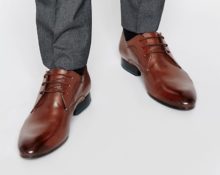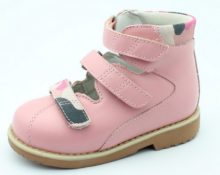When hiking or jogging along a forest path, you need trekking shoes. It will protect your feet and allow you to enjoy your walk without worrying about blisters or wet socks.
What kind of shoes are trekking shoes?
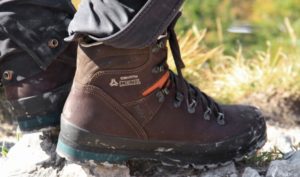 These are travel shoes. It is durable and light, does not allow moisture to pass through, and it is easier for the foot to breathe in such shoes. They walk in it where there is no asphalt or even paths.
These are travel shoes. It is durable and light, does not allow moisture to pass through, and it is easier for the foot to breathe in such shoes. They walk in it where there is no asphalt or even paths.
The main thing in such shoes is sole made of special rubber with developed tread. A thick sole with good shock absorption reduces the load on the foot and spine. With this outsole you can walk longer distances with more weight.
Advantages and disadvantages
Travel boots and sneakers are more expensive and heavier than everyday shoes. They are designed for touring purposes and are not comfortable if worn every day. But they are indispensable when traveling. Advantages of trekking shoes:
- The special sole creates better grip. The foot will not slip on clay or rocky roads;
high boots secure the ankle. This protects your ankles from sprains; - Toe overlays and a thick outsole help you step up in the snow or dirt. This makes it more convenient to stand on an uneven surface;
- protection of the toe and heel saves the foot when hitting a sharp stone;
- the membrane inside the boots retains moisture. Your feet will stay dry longer.
Functions of membrane in shoes
The inner lining is often made of a protective membrane that does not allow moisture to pass through - the foot stays dry longer. This does not mean that rivers are crossed in such shoes - the leather or fabric is also saturated with moisture. When there is a lot of it, the material cannot cope and allows water to pass through. If there is little moisture, the membrane will keep your feet dry. It also keeps you warm in cold weather.
This lining is an optional part of trekking shoes. It is useful for traveling in the rain or through melted snow. But along with water, the lining is less breathable. The skin breathes worse, the feet sweat. This is unpleasant in hot weather. So if you're hiking in dry weather, look for boots that don't have a membrane.
Important! Gore-Tex or eVent labels on shoes indicate that a protective membrane is already sewn into the lining.
Types of trekking shoes
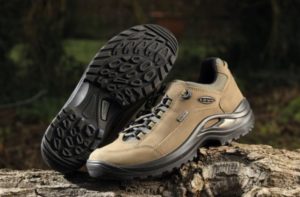 Different trekking shoes are used for different trips. These can be sneakers for off-road running, or heavy boots for hiking on sharp rocks. To choose the right shoes for travel, decide on the route and understand what is more important to you - speed or safety.
Different trekking shoes are used for different trips. These can be sneakers for off-road running, or heavy boots for hiking on sharp rocks. To choose the right shoes for travel, decide on the route and understand what is more important to you - speed or safety.
Off-road running shoes
This low-top sneakers with deep tread. The upper is made of mesh fabric to allow the foot to breathe better. The sole is made of soft materials, so you need to run carefully in such shoes - stones or sharp objects can damage your foot. These sneakers are suitable for jogging where there is no road, but not for long hikes.They do not secure the leg and do not protect against injury. On average, they can withstand a distance of 600 km. Then either the sole wears off or the seams come apart.
Lightweight sneakers
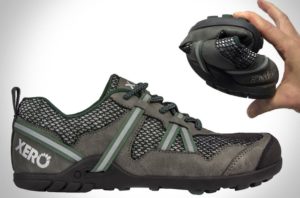 This is no longer for running, but for one-day walks through the forest or mountain paths. They have thicker soles than running shoes, so they provide better shock absorption and ease stress on the spine. A rigid heel and a sewn toe will increase stability and protect the foot from small stones. These shoes take longer to wear out than running shoes. If you're looking forward to a short trip with a 2-3kg backpack, wear these shoes.
This is no longer for running, but for one-day walks through the forest or mountain paths. They have thicker soles than running shoes, so they provide better shock absorption and ease stress on the spine. A rigid heel and a sewn toe will increase stability and protect the foot from small stones. These shoes take longer to wear out than running shoes. If you're looking forward to a short trip with a 2-3kg backpack, wear these shoes.
Hiking boots
This transitional stage between hiking boots and sneakers. In these boots you can go hiking on country roads and paths with a heavy backpack for 3-4 days. It is recommended to walk no more than 15 km per day. They are higher than sneakers and better protect the lower leg from dislocations and injuries. The sole is made of EVA rubber and has good shock absorption. The boots themselves are made of lightweight materials, often with holes, so they get wet quickly and are not suitable for cold and wet weather.
Medium-heavy boots
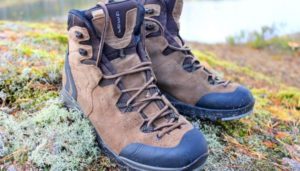 They protect and support the lower leg better than the previous type of shoe due to the high top. Suitable for hiking on washed out trails and severe off-road conditions. Or for trekking to mountains no higher than 3 thousand meters with a heavy backpack. The multi-layer outsole is made with powerful, self-cleaning treads. They have rigid toe protection. The upper is made of leather, suede or fabric with a lot of seams.
They protect and support the lower leg better than the previous type of shoe due to the high top. Suitable for hiking on washed out trails and severe off-road conditions. Or for trekking to mountains no higher than 3 thousand meters with a heavy backpack. The multi-layer outsole is made with powerful, self-cleaning treads. They have rigid toe protection. The upper is made of leather, suede or fabric with a lot of seams.
Heavy trekking boots
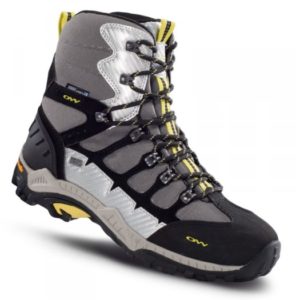 This for long routes without trails. They weigh from 1 kg, so your legs get tired faster. But the rigid design secures the shin well and protects against dislocations. These boots are comfortable to walk on rocks.They have a very thick sole, a minimum of seams, and additional protection from moisture. They are wear-resistant. Some models have built-in mounts for soft crampons, so they are used for simple climbing tasks. These are SUVs for heavy, multi-day hikes.
This for long routes without trails. They weigh from 1 kg, so your legs get tired faster. But the rigid design secures the shin well and protects against dislocations. These boots are comfortable to walk on rocks.They have a very thick sole, a minimum of seams, and additional protection from moisture. They are wear-resistant. Some models have built-in mounts for soft crampons, so they are used for simple climbing tasks. These are SUVs for heavy, multi-day hikes.
Mountaineering boots
Shoes for extreme conditions. It is only worn for rock climbing and mountain climbing if you need to use crampons. It is uncomfortable to walk on trails in it. These boots are heavy, but strong, with a high top. The top of the shoe is made of plastic, leather or synthetic materials.
Important! Most trekking shoe models are designed for men. But stores also sell women's models with a higher instep and lower height to better fit a woman's foot.
Weight and fit when choosing shoes
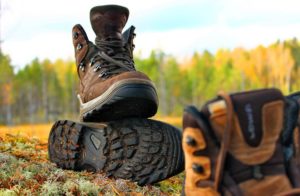 The lighter the shoes, the longer the distance covered per day.. But don't forget about shin protection. Once you have determined the category of boots you need, choose something that is not heavy but is safe enough for your shin.
The lighter the shoes, the longer the distance covered per day.. But don't forget about shin protection. Once you have determined the category of boots you need, choose something that is not heavy but is safe enough for your shin.
It is better to try on trekking shoes with socks. Put on the boot and push your foot as far as possible. If the size is correct, your index finger should fit between the back of the boot and the heel. Now lace up the boot and move your toes - they should not touch the toe of the boot from the inside. If something between two sizes seems to fit, add larger insoles or two insoles to your boots. For a precise fit, try adjusting the lacing - tight bottom and loose shaft, or vice versa. With the help of insoles and lacing, the boots are adjusted exactly to the foot.
Important! Try to buy boots a week before your hike. They need to be distributed.



 1
1

